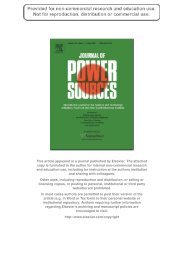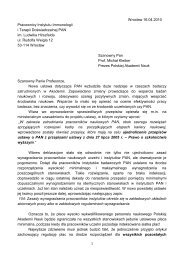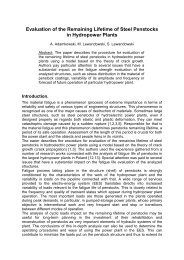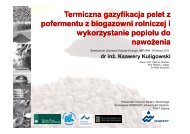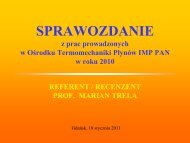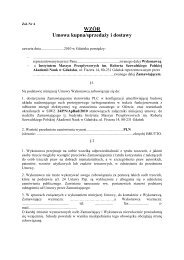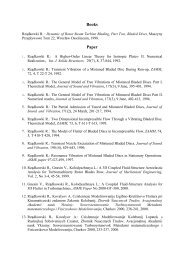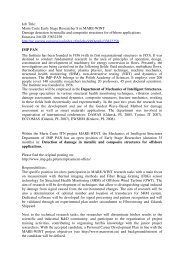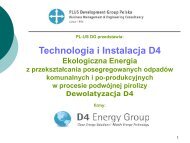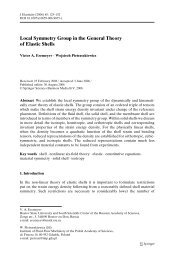Phenomenological models of cavitation erosion kinetics
Phenomenological models of cavitation erosion kinetics
Phenomenological models of cavitation erosion kinetics
- No tags were found...
You also want an ePaper? Increase the reach of your titles
YUMPU automatically turns print PDFs into web optimized ePapers that Google loves.
J.Steller, P.Kaczmarzyk: <strong>Phenomenological</strong> <strong>models</strong> <strong>of</strong> <strong>cavitation</strong> <strong>erosion</strong> progress. 5The formula proposed by K.Steller is based on the notion <strong>of</strong> <strong>cavitation</strong> resistance R cav ,clearly linked to that <strong>of</strong> A.P.Thiruvengadam's <strong>erosion</strong> strength [7] and defined by the equation:Pt = R cav ∆V (6)where P is the power used to erode the material subject to <strong>cavitation</strong> impingement. Cavitationis assumed a continuous process (proceeding at variable speed) resulting in the change <strong>of</strong> bothmaterial surface and its internal structure, responsible for <strong>cavitation</strong> resistance. Cavitationresistance dependence on duration <strong>of</strong> <strong>cavitation</strong> impingement is assumed to be described byan exponentially decreasing functionThe formula derivedRcav( 1+χ )−κtχ + e=1 R 0χ +Pt2 1≈σ∆V=−κt2R0( χ + e )( + χ )EPt−κt( χ + e )shows clear dependence <strong>of</strong> the volume loss curve ∆V = ∆V(t) on some basic material parameters(modulus <strong>of</strong> elasticity E and ultimate stress values σ), χ factor determining the ratio <strong>of</strong>ultimate and initial <strong>cavitation</strong> resistance (equation (7)), κ parameter defining the speed <strong>of</strong><strong>cavitation</strong> resistance decrease in course <strong>of</strong> the process and power P used to erode the material.In mid eighties L.Sitnik [8] assumed the time interval ∆t between removal <strong>of</strong> the consecutiveparticles from the material surface to be a random function with a three-parameterlogarithmic-natural distribution functionThe volume loss curve derived takes the formFpβ p{ }( ∆t) = 1 − − α [ ln ( ∆t∆t0 + 1)]p(7)(8)exp . (9)β p[ ( t ∆t∆V= α ∆Vln 1)]p0 0 +with ∆V 0 denoting certain characteristic volume value. The α p parameter is characteristic forthe intensity <strong>of</strong> erosive action <strong>of</strong> the phenomenon. It is worthwhile to notice that the model isa simplified version <strong>of</strong> the F.J.Heymann model.(10)3. DETERMINING THE VOLUME LOSS CURVE PARAMETERSACCORDING TO THE SELECTED MODELSOF CAVITATION EROSION KINETICSThe least squares method has been adopted in order to determine the volume loss parametersaccording to selected <strong>models</strong>. The task can be reduced to that <strong>of</strong> minimising the expression2[=∑α∆V−χ ( k)U kjjj( , t )]with α j denoting the weight coefficient, U( . , t) - a function describing <strong>erosion</strong> progress accordingto the model selected, and k - a set (vector) <strong>of</strong> parameters to be determined by means<strong>of</strong> the minimising procedure.During calculations <strong>of</strong> that kind particular attention should be brought to an appropriateselection <strong>of</strong> the zero-th approximation.j2,(11)



